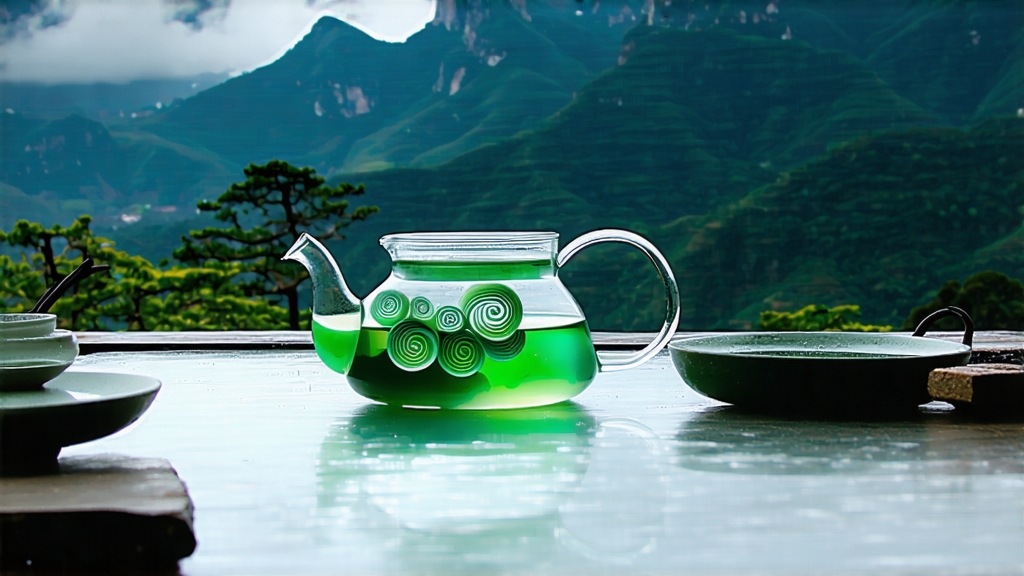
Tucked between the mist-laden peaks of Lake Tai in Jiangsu Province, Biluochun—literally “Green Snail Spring”—is one of China’s ten most celebrated teas, yet it remains a quiet revelation for many overseas drinkers. Its name alone evokes poetry: “green” for its emerald liquor, “snail” for the tight spiral each leaf forms, and “spring” because it is plucked during the brief lunar window when the hills awaken from winter dormancy. Unlike the flattened blades of Longjing or the needle-sharp elegance of Huangshan Maofeng, Biluochun presents itself as a thousand tiny jade snails, each coil guarding the fragrance of apricot blossoms and roasted chestnuts. To understand this tea is to step into a 1,200-year-old story that intertwines imperial whim, Buddhist monks, and the micro-climate of an island-shaded lake.
Historical whispers place Biluochun’s birth during the Tang dynasty, when tea growers along Dongting’s eastern ridge noticed that leaves picked beside fruit trees absorbed their perfume. By the Song era the tea—then called “Xia Sha Ren Xiang” (literally “astounding fragrance”)—was tribute, ferried up the Grand Canal to the northern courts. Legend claims the Kangxi Emperor, touring the south in 1699, was so enchanted by the spirals unfurling in his porcelain cup that he rechristened the tea “Biluochun,” deeming the original name too vulgar for so delicate a brew. Whatever the truth, imperial patronage cemented its reputation, and Qing-era poets compared its aroma to “a spring orchard locked inside a raindrop.”
Today the appellation “Biluochun” is protected; only leaf grown within the Dongting东山 (East Mountain) and西山 (West Mountain) peninsulas of Wuzhong District may legally bear the name. Within this micro-region lie two distinct styles. Dongshan tea, grown on gentle south-facing slopes of weathered quartz and clay, yields a creamier body and pronounced orchid note. Xishan gardens, perched on steeper, granite-based inclines lashed by lake winds, produce a sharper, more mineral cup with a lingering sweet-pea finish. Purists further divide the harvest into five grades: Supreme (mingqian, pre-Qingming), Special (yuqian, pre-Grain Rain), First, Second, and Third, with plucking standards tightening from one bud to one bud-and-one-leaf to one bud-and-two-leaves as the season advances.
The crafting of Biluochun is a race against time and enzymatic browning. Picking begins at dawn when the leaf’s moisture content is highest and surface temperature lowest; workers wear cotton gloves to prevent fingerprint bruising. Within four hours the fragile shoots must reach the village withering troughs—shallow bamboo baskets set under shade cloth where they lose roughly 10 % moisture and develop a faint grassy sweetness. Next comes the only mechanized step: a tumble in a 60 °C rotary drum for 90 seconds to soften cell walls without roasting. What follows is entirely manual and hypnotic to watch. A master “kills the green” (shaqing) on a cast-iron pan maintained at 180 °C, tossing the leaves with bare hands every second for three minutes; the gesture looks like a pianist glissandoing across hot keys. The temperature is then dropped to 80 °C for the first rolling phase, where wrist pressure coils the bud around its minute stem. After five minutes the leaves are removed, allowed to cool, and re-fired at 70 °C while the artisan increases pressure, shaping the iconic spiral. A final low-temperature bake at 50 °C for 40 minutes locks in fragrance and reduces residual moisture to below 5 %. The entire process consumes 70,000 buds to yield barely 500 g of finished tea, explaining why top-grade Biluochun can command over a thousand dollars per kilogram.
Water is the silent ingredient. Lake Tai’s soft, slightly acidic profile (pH 6.2) mirrors the ideal brewing medium, so local brewers simply draw from their backyard wells. For international drinkers stuck with harder tap water, filtration is essential; minerals above 100 ppm flatten the tea’s fruit notes and exaggerate bitterness. Measure 3 g of leaf—about a heaping teaspoon—for every 150 ml vessel. Pre-warm the glass or gaiwan, then cool the water to 70 °C; anything hotter scalds the downy tips and releases